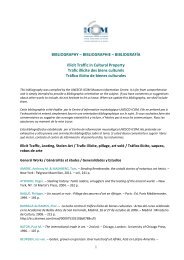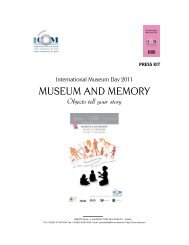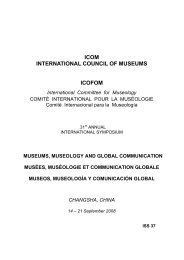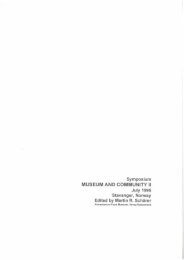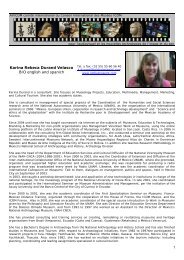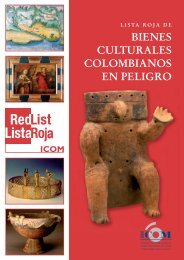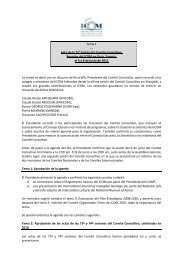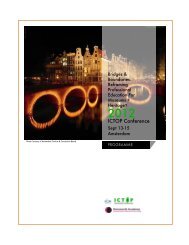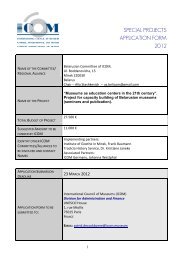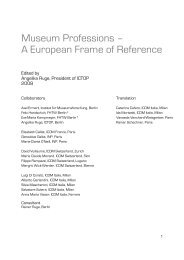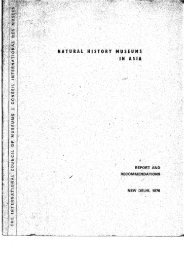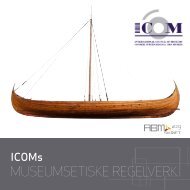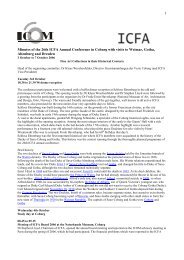Key Concepts of Museology - ICOM
Key Concepts of Museology - ICOM
Key Concepts of Museology - ICOM
You also want an ePaper? Increase the reach of your titles
YUMPU automatically turns print PDFs into web optimized ePapers that Google loves.
30<br />
not mean that the visitor is not personally<br />
involved (whether interactively<br />
or not) in this type <strong>of</strong> communication<br />
( Hooper-Greenhill, 1991); (2) it is not<br />
essentially verbal, nor can it really be<br />
compared with reading a text (Davallon,<br />
1992), but it works through the<br />
sensory presentation <strong>of</strong> the objects<br />
exhibited: “The museum as a communication<br />
system, then, depends<br />
on the non-verbal language <strong>of</strong> the<br />
objects and observable phenomena.<br />
It is primarily a visual language, and<br />
at times an aural or tactile language.<br />
So intense is its communicative power<br />
that ethical responsibility in its use<br />
must be a primary concern <strong>of</strong> the<br />
museum worker” (Cameron, 1968).<br />
3. More generally speaking, communication<br />
gradually became the<br />
driving force <strong>of</strong> museum operations<br />
towards the end <strong>of</strong> the 20 th century.<br />
This means that museums communicate<br />
in a specifi c way (using their own<br />
methods), but also by using all other<br />
communication techniques, possibly<br />
at the risk <strong>of</strong> investing less in what<br />
is most central to their work. Many<br />
museums – the largest ones – have<br />
a public relations department, or a<br />
“public programmes department”,<br />
which develops activities aimed at<br />
communicating to and reaching<br />
various sectors <strong>of</strong> the public that are<br />
more or less targeted, and involving<br />
them through traditional or innovative<br />
activities (events, gatherings,<br />
publications, extramural activities,<br />
etc.), In this context the very large<br />
sums invested by museums in their<br />
internet sites are a signifi cant part <strong>of</strong><br />
the museum’s communication logic.<br />
Consequences include the many digital<br />
exhibitions or cyber-exhibitions<br />
(a fi eld in which a museum may have<br />
genuine expertise), on-line catalogues,<br />
more or less sophisticated<br />
discussion forums, and forays into<br />
social networks (YouTube, Twitter,<br />
Facebook, etc.).<br />
4. The discussion regarding the<br />
communication methods used by the<br />
museum raises the question <strong>of</strong> transmission.<br />
The chronic lack <strong>of</strong> interactivity<br />
in museum communication has<br />
led us to ask ourselves how we can<br />
make the visitor more active, while<br />
seeking his participation (McLuhan<br />
and Parker 1969, 2008). We could,<br />
<strong>of</strong> course, remove the labels or even<br />
the story line so that the public could<br />
build their own rationale as they<br />
move through the exhibition, but<br />
this would not make the communication<br />
interactive. The only places<br />
where a degree <strong>of</strong> interactivity has<br />
been developed (such as the Palais de<br />
la Découverte, the Cité des sciences et<br />
de l’industrie in Paris, or the Exploratorium<br />
in San Francisco) seem closer<br />
to amusement parks that develop<br />
fun attractions. It appears nevertheless<br />
that the real task <strong>of</strong> the museum<br />
is closer to transmission, understood<br />
as unilateral communication over<br />
time so that each person can assimilate<br />
the cultural knowledge which<br />
confi rms his humanity and places<br />
him in society.<br />
CORRELATED: CULTURAL ACTION, EXHIBITION,<br />
EDUCATION, DISSEMINATION, INTERPRETATION, MEDIA,<br />
MEDIATION, TRANSMISSION, PUBLIC AWARENESS, PUBLIC<br />
RELATIONS.



